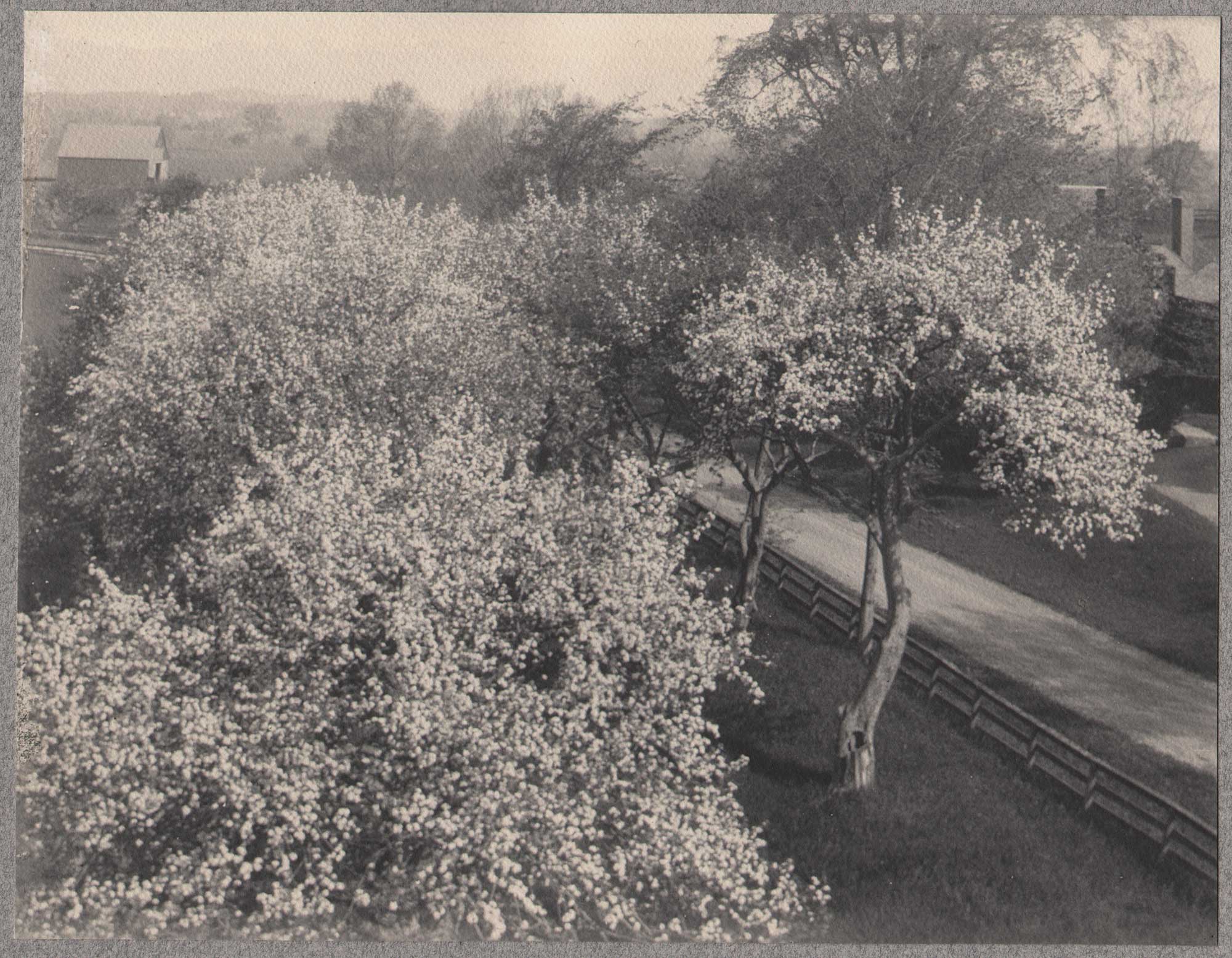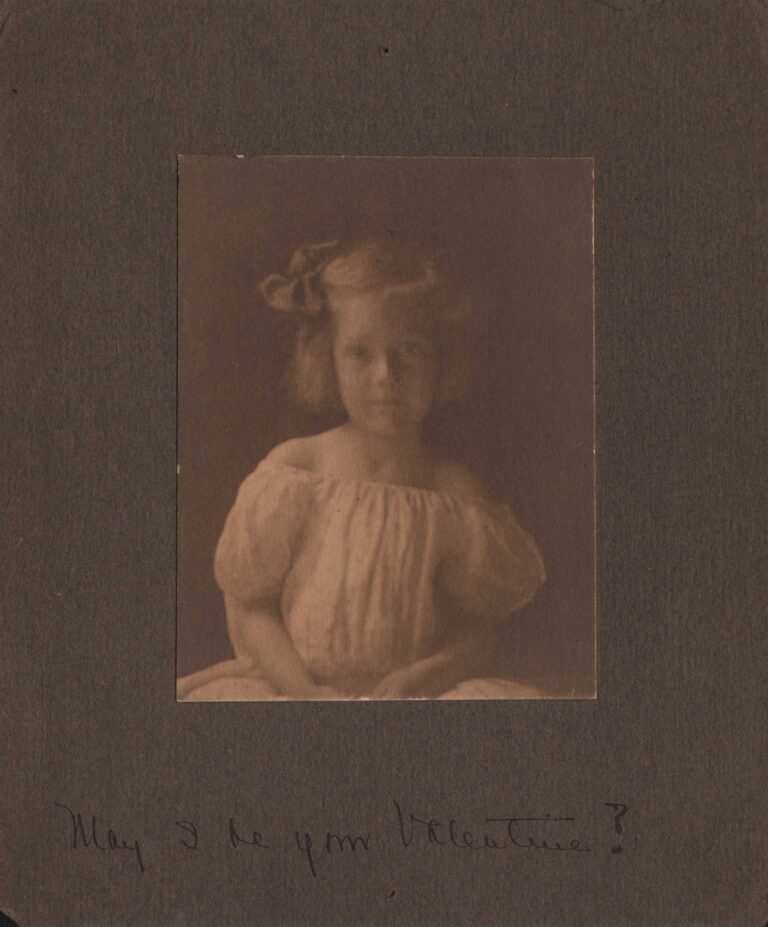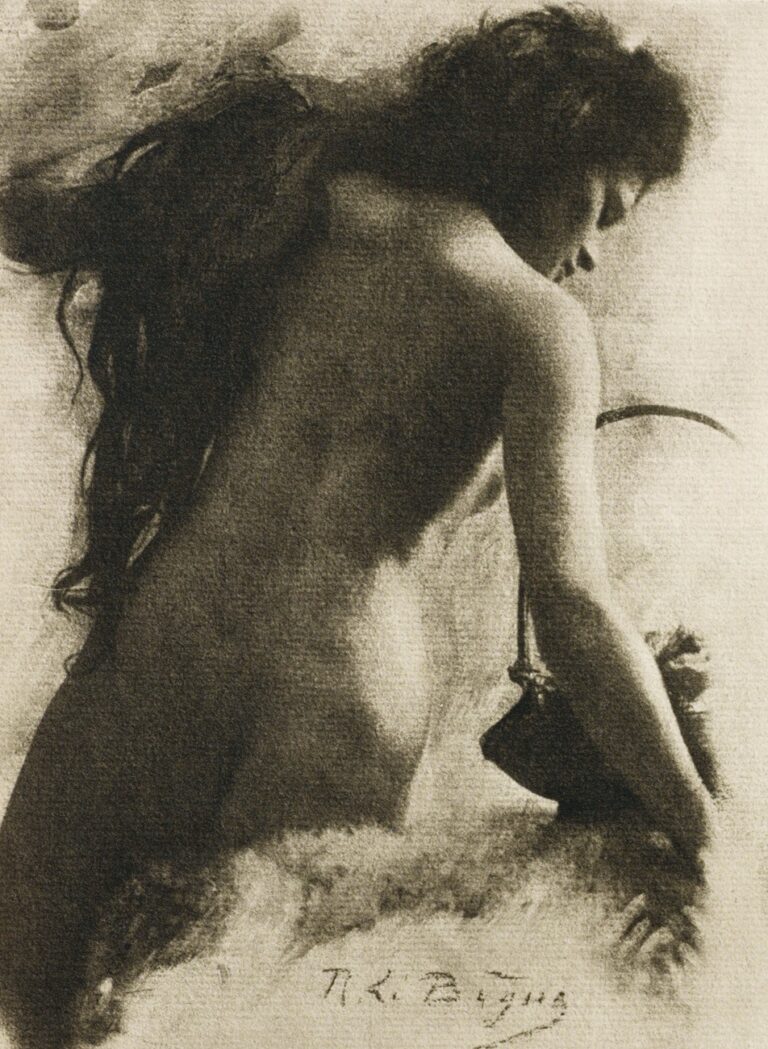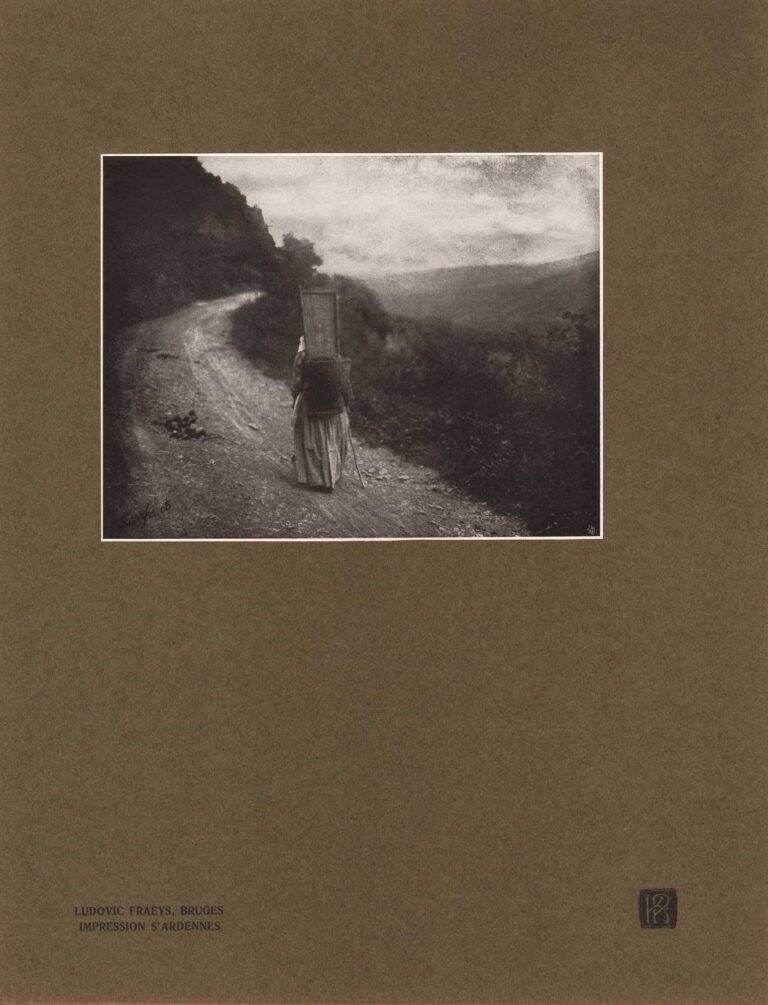
Flowering Apple Trees
In an orchard, apple trees show off their flowers in Spring. Seen from a high angle, with a fence and roadway at right, this view was most likely taken on a farm in the greater Wayland, MA area. From Wikipedia: “An apple is a round, edible fruit produced by an apple tree (Malus spp.). Fruit trees of the orchard or domestic apple (Malus domestica), the most widely grown in the genus, are cultivated worldwide. The tree originated in Central Asia, where its wild ancestor, Malus sieversii, is still found. Apples have been grown for thousands of years in Eurasia before they were introduced to North America by European colonists. Apples have cultural significance in many mythologies (including Norse and Greek) and religions (such as Christianity in Europe).” (accessed: April, 2025)
Alfred Wayland Cutting, Photographer
The following overview of Massachusetts resident Alfred Wayland Cutting’s involvement with photography, followed by his biography is courtesy of Historic New England: Ellie Reichlin, “The Old Life Silently Passed: Photographs by Alfred Wayland Cutting (1860-1935),” exhibition brochure; Glynys Thomas, “The Papers of Alfred Wayland Cutting, 1863-1933)”, finding aid.
Cutting papers
The majority of the Alfred Wayland Cutting papers is made up of his photographs, but also includes correspondence (including 27 letters received from friend and neighbor Lydia Maria Child) and letters to his nieces and grand-nephews and nieces. A small collection of printed matter includes Cutting’s valedictory address given to his graduating class at the Dwight School (1876), typescripts of other papers, a manuscript of his memoirs (1926), and diaries. The rest of the collection is comprised of approximately 2,852 of his photographs, some mounted in albums, others loose or framed, as well as glass negatives, lantern slides, and copies of photography magazines.
Alfred Cutting extolled beauty and savored the joys of rural life. He loved Wayland, Massachusetts, where his ancestral roots ran generations deep, with a devotion that verged on reverence.
Cutting acquired his first camera in 1881, culminating years in which he “haunted the photo-stock houses of the day and lovingly handled the cameras and lenses, wondering if I could not learn to use them and manipulate the mysterious chemicals.” With the advent of the dry-plate negative, adapted to the needs of amateurs, he was able to realize his “dream of making my first photograph thus [beginning] what has been one of the greatest joys of my life.” At first he aspired to landscape: “Portraits did not appeal to me at all; it was pictures of the tree-shaded roads, rocks, hills and water, of the lovely country . . . that even as a boy, I loved so passionately . . . that I yearned to make.”
Passion, joy, yearning, and dreaming are common to Cutting’s vocabulary, as, implicitly, they are to his photographs. Their roots may have been his deep childhood attachment to the remarkable Mrs. Child, who-even 45 years later-he remembered with unalloyed warmth and admiration. This warm relationship may have influenced his photography, and its glow is present in luminous portrayals of young people (their eyes perhaps as beautiful to him as his had been to the woman he called “Mitty Chile”), and in the ravishing freshness of some of his flower and nature studies.
Cutting’s first photograph, a view of Worcester Square in Boston, hardly suggests the poetic direction of his future works, which numbered nearly four thousand by 1927. All of these he personally printed, typically on platinum papers, whose soft tones were ideally suited to the contemplative style of his imagery. Not surprisingly, Wayland’s natural scenery, and the naturalness of childhood–both bound together in his memory as “joyous”–pervade his work, which at best achieves a pictorial universality that goes well beyond the inherently picturesque charm of his subject matter.
There were also travel views, made during visits to Europe and North Africa at the turn of the century, but these ceased in 1913, when he became a confirmed stay-at-home, not venturing further than Cape Cod and Nantucket. He compiled an example “of every picture of any interest I have ever made” into twenty-five dated albums, “comprising a record of the fairest things I have seen anywhere.” The pages are carefully designed, the photos fastidiously mounted. The absence of text or identification suggests the albums were intended for personal reverie, to be read as one might a panorama, in which images of freshness and youth move gracefully through time, their beauty progressively augmented by Cutting’s growing mastery over his medium.
For all the local significance of Cutting’s work, it would be a mistake to characterize him principally as a Wayland photographer, or as Wayland’s photographer, even though he-with Yankee disdain for the high-falutin’-might have protested efforts to intellectualize or magnify his accomplishments. He described himself unpretentiously as an “amateur or semi-professional.”
This characterization downplays the fact that Cutting was an intensely serious photographic artist and craftsman, steeped in the precepts of art photography and pictorialism, which emerged in the late 1880s and early 1890s as a liberating alternative to the sharply detailed documentary styles that had dominated photography’s first four decades. The movement was advanced by “the army of amateurs,” who, like Cutting, had joined the ranks of photographers in the early 1880s, when the introduction of the dry plate enormously simplified the use of the camera. Expressiveness, naturalism, experimental artistic effects, subdued lighting, soft focus, tonal subtlety, varied papers, cropping methods, and mounting techniques were among its aesthetic cods-as was a preference for nature studies and unselfconscious portraiture-both of which dominate Cutting’s work.
Though he entered-and frequently won-photographic competitions sponsored by “Photo-Era,” a publication for amateurs with a pictorialist bent, there is little evidence that Cutting sought recognition as an art photographer outside the local area, either through national competitions and salons or membership in the elite Photo-Secession, a society open to all Americans interested in advancing photography as “pictorial expression.”
Biography: Alfred Wayland Cutting: 1860-1935
Alfred Wayland Cutting was born in Boston on February 16, 1860, the second son and third child of Marcia Roby Drury Cutting (1831-1917) and Charles Alfred Cutting (1822-1914). He had four siblings: Charles Franklin (1851-1896), Mary Elizabeth (1854-1896), who married Edwin Buckingham Buckingham in 1874, Marcia Sophia “Madge” (1861-1931) and William Warren who died in infancy. After the death of Mary Elizabeth and her husband Edwin Buckingham, Cutting and his sister Madge became the guardians of their nieces, Marian and Leslie Buckingham.
Cutting attended the Dwight Grammar School followed by three years at English High School. He then became a teller at the Massachusetts Trust Company in Boston, a position he held until 1903, when he moved to Wayland permanently. Throughout a “joyous childhood” he spent months at the Cutting family farm, adjacent to the cottage owned by abolitionist-author Lydia Maria Child (1802-1880) and her husband, David. In 1881, following Mrs. Child’s death, her house became the Cutting family’s new home-saturated with recollections of ripe fruits, flowers, and childish games. Here Alfred Cutting lived until his death in 1935, maintaining a studio in a vine-covered building. Eighteenth-century paneling on the studio walls formed the backdrop for Cutting’s portraits, which became the major focus of his work after 1900.
Cutting was also a life-long member of the First Parish Church of Wayland and a founding member and treasurer of the Wayland Society of Arts and Crafts.
Madge died in 1931 and Alfred four years later in 1935. He left the bulk of his fortune, mainly acquired through inheritance and investment, to his niece, Marian Buckingham Sears.



